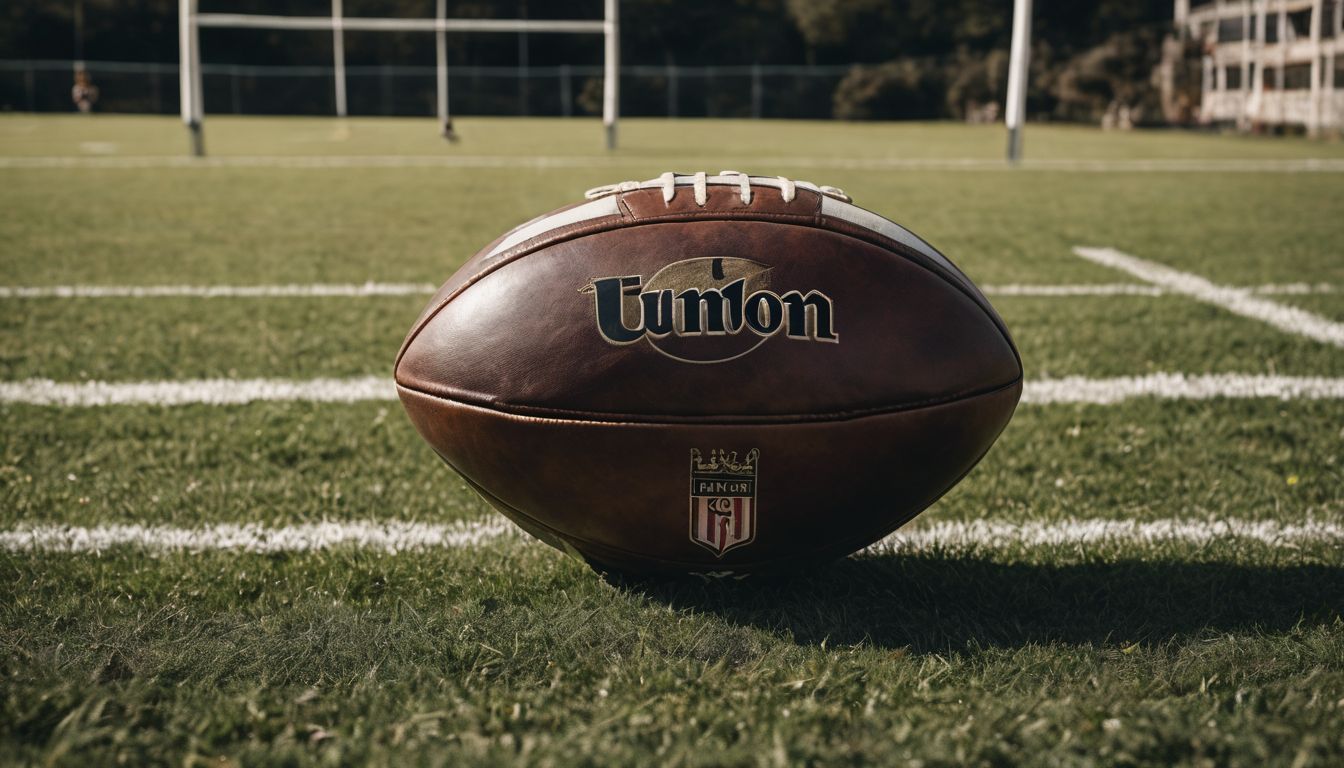Are you ever left puzzled watching rugby, wondering what counts as a proper tackle? A tackle is when a ball carrier gets brought to the ground by the opposing team. This article will clear up any confusion around tackling rules in rugby, so you can understand every clash on the pitch.
Let’s dive right into the heart of this thrilling sport!
Key Takeaways
- A tackle in rugby requires bringing the ball carrier to the ground by holding them until they are fully down, targeting below the sternum for safety.
- Players must understand low vs high tackling; low is safer and legal while high can cause injuries and lead to severe penalties including yellow or red cards.
- Proper technique involves precise head, body, arm, and leg positioning to prevent concussions and other serious injuries like neck or spinal damage.
- Tackling rules stipulate players can only tackle the ball carrier; illegal tackles on non – ball handlers result in penalties and loss of possession.
- Mastering good tackling skills is essential not just for player safety but also for effective defence, preventing opponents from advancing and creating turnover opportunities.
Definition of a Tackle in Rugby
A tackle in rugby is the act of bringing the ball carrier to the ground, a necessary skill for defending and stopping the opposing team. It is a fundamental aspect of the game and requires proper technique to ensure safety for all players involved.
A necessary skill in rugby
Mastering the art of tackling is essential in rugby. Players must learn to effectively bring down their opponents who hold the ball, doing so within the rules for both safety and strategic advantage.
Not only does a well-executed tackle disrupt the play of the opposing team, but it also sets up opportunities for your own side to regain possession or push forward on the field.
To execute a proper tackle, players aim below the sternum, ensuring initial contact doesn’t go too high and risk penalties or injury. It requires precision and practice because once on ground, you must continue holding them until they’re fully down—a clear demonstration that power and control are as vital as technique.
The skill of tackling forms a pillar in rugby; without it, defending becomes virtually impossible against advancing opponents eager to score tries.
Bringing the ball carrier to the ground
To bring the ball carrier to the ground, a player in possession of the ball must be held by one or more opponents and taken down. The tackler needs to maintain contact until the ball carrier is on the ground.
This is a key part of rugby as it allows for turnovers and keeps play moving forward.
Tackling in rugby involves precise technique and an understanding of rules. To effectively execute a tackle, players need to target and make initial contact below the sternum, ensuring safety for all involved.
Moreover, only the player with possession of the ball can be tackled; any other action results in penalties for illegal tackles.
The Importance of Tackling
Tackling is a fundamental aspect of rugby, essential for defending and stopping the opposing team from advancing. It requires skill and precision to execute effectively.
https://www.youtube.com/watch?v=seQvXqK8FUk
A fundamental aspect of the game
Tackling is an essential and integral part of rugby, serving as a vital defensive technique. It requires precise timing, strength, and strategy to prevent the opposing team from making progress with the ball.
Successful tackling not only stops the ball carrier but also creates opportunities for turnovers and regaining possession. In rugby union, players must adhere to specific rules regarding body positioning, targeting areas for contact, and ensuring player safety during tackles.
This fundamental aspect of the game demands discipline and skill to effectively defend against opponents’ advances.
The art of tackling in rugby is crucial not only for stopping the opposition’s momentum but also for maintaining a strong defensive line at all times. The impact of a well-executed tackle reverberates throughout the game by disrupting attacking plays and offering opportunities to regain control or launch counter-attacks.
Necessary for defending and stopping the opposing team
Mastering the art of tackling is vital for defending and halting the opposing team’s advances in rugby. It serves as a crucial defensive skill, allowing players to quickly regain possession or prevent the opposition from gaining ground.
Properly executed tackles can disrupt the flow of play, forcing turnovers and thwarting scoring opportunities. By adhering to the rules of tackling, defenders can effectively neutralise their opponents and protect their own try line, ultimately shaping the momentum of the game.
An effective tackle not only stops an opponent but also shifts momentum in favour of the defending team. Subduing an attacking player through a well-executed tackle can swing possession back into your team’s hands and even create scoring chances on counter-attacks.
Rules of Tackling in Rugby
In rugby, there are specific rules and regulations governing tackling. This includes low vs high tackling, head positioning, body positioning, arm placement, leg placement, and laws around holding the ball and the ball on the ground.
Low vs high tackling
Low tackling is the preferred method in rugby, as it targets the legs of the ball carrier and reduces the risk of injury. This technique involves using proper body positioning to make contact below the sternum.
In contrast, high tackling, which involves making contact above the sternum, can lead to penalties due to increased risk of head and neck injuries. It’s crucial for players to understand and implement low tackling techniques to ensure safety for both themselves and their opponents.
High tackles can result in severe penalties such as yellow or red cards, as they pose a significant risk to player safety. On the other hand, low tackles are not only safer but also more effective in bringing down opponents while complying with rugby rules.
Head positioning
Tackling in rugby requires precise head positioning to ensure safety and effectiveness. The tackler should aim to have their head behind or to the side of the ball carrier, avoiding contact with their opponent’s head.
This is crucial for reducing the risk of concussions and other serious injuries that can result from improper head placement during tackles. By adhering to proper head positioning, players can execute tackles confidently while prioritising the well-being of both themselves and their opponents.
To maintain player safety and uphold fair play, rugby laws stipulate specific guidelines for head positioning during tackling. Placing emphasis on correct technique will ultimately contribute to a safer and more enjoyable game for all involved.
Body positioning
Transitioning from head positioning to body positioning, the correct body posture is crucial for a successful tackle in rugby. Players need to maintain a low centre of gravity and keep their feet shoulder-width apart to ensure stability and balance during the tackle.
The tackler must position themselves in front of the ball carrier, focusing on driving their shoulder into the opponent’s midsection while maintaining a strong and stable core. This technique not only aids in effectively bringing down the ball carrier but also minimises the risk of injury for both players involved.
Not only does proper body positioning contribute to an effective tackle, but it also ensures player safety by reducing the risk of head-on collisions. Rugby fans understand that mastering these fundamental techniques is essential for every player aiming to excel at this dynamic sport.
Arm placement
Transitioning from body positioning, the next crucial element in a successful rugby tackle is arm placement. When executing a tackle, the tackler’s arms should be used to grasp and hold onto the ball carrier securely.
This not only ensures that the opponent is brought down effectively but also prevents them from offloading the ball to another player. Moreover, proper arm placement can help protect both the tackler and the ball carrier from potential injuries, maintaining safety on the field.
The laws of rugby specifically dictate that when making contact in a tackle, players must use their arms to wrap around the opposing player’s body below the sternum. This holds true for both initial contact and subsequent wrapping of arms while taking down an opponent.
Leg placement
Players must aim to make contact with their legs when tackling in rugby. The laws of the game dictate that all tackles must target and initially connect below the sternum, emphasising the importance of proper leg placement during a tackle.
This technique not only promotes player safety but also ensures fair play, as it reduces the risk of high tackles that can lead to serious injuries for both the tackler and ball carrier.
Understanding and adhering to these rules is essential for rugby players, as correct leg placement contributes to effective and lawful tackling in the game.
Holding the ball and ball on ground laws
When tackling in rugby, it is crucial to remember that the ball carrier must be held until they are on the ground. The tackler needs to continue holding the ball carrier until this happens, ensuring a fair and legal tackle.
Additionally, players can only tackle the individual who has possession of the ball – tackling a non-ball handler will result in a penalty and loss of possession. Adhering to these laws ensures player safety and fair play while maintaining possession for their team.
Moving on to another important aspect of rugby, let’s discuss “Possible Injuries from Illegal Tackling” and how players can avoid them.
Possible Injuries from Illegal Tackling
Illegal tackling can lead to serious injuries such as concussions, neck and spinal injuries. It is important for players to adhere to proper tackling techniques to prevent these potential dangers on the field.
Concussions
Concussions are a significant concern in rugby, often resulting from high-impact tackles. As defined by the laws of rugby, all tackles must target and initially contact below the sternum to minimise the risk of head injuries.
The importance of proper tackling technique cannot be overstated, as it directly relates to player safety. Understanding this is crucial for players looking to protect themselves and their opponents.
Proper education on recognising concussion symptoms is essential for both players and referees, ensuring timely intervention when needed. In line with this, referees have a responsibility to enforce rules that prioritise player safety above all else.
Neck and spinal injuries
Neck and spinal injuries can occur as a result of improper tackling in rugby. Players must adhere to the rules regarding head positioning, as any form of contact above the sternum during a tackle can lead to serious neck and spinal injuries.
Rugby fans should be aware of the importance of proper technique when it comes to tackling, as incorrect execution can result in severe consequences for both the player initiating the tackle and the ball carrier.
Furthermore, understanding the risks associated with illegal tackling is crucial for players to ensure their own safety and that of their opponents. Adherence to specific regulations concerning head positioning and body contact is essential in preventing potential neck and spinal injuries on the rugby field.
Importance of proper tackling technique
To avoid the risk of neck and spinal injuries, rugby players must master the importance of proper tackling technique. Understanding and implementing correct form not only minimises potential harm to themselves and their opponents but also allows for more effective defensive play.
With an emphasis on low tackles and controlled body positioning, players can prevent dangerous high-impact collisions while maintaining strategic advantage in the game. Consistent adherence to tackling regulations ensures player safety as well as fair competition, underscoring the crucial role of mastering proper technique in rugby.
Conclusion
In rugby, a tackle is an essential skill used to bring the ball carrier to the ground. It’s crucial for defending and stopping the opposing team. Tackling involves specific rules and techniques, ensuring player safety and fair play.
Understanding these rules is vital for both defensive and offensive purposes in the game. Players must adhere to these regulations to avoid penalties while enjoying this exciting sport.
FAQs
1. What exactly is a tackle in rugby?
A tackle in rugby is when a player grabs and brings an opponent with the ball to the ground.
2. Can you explain what a ruck is?
After a tackle, if players from both teams are on their feet and over the ball, it’s called a ruck.
3. What happens during a maul in rugby?
A maul occurs when the ball carrier is held but not brought to ground, with at least one other player from each team binding onto them.
4. Are scrums and lineouts part of tackling rules in rugby?
Scrums and lineouts aren’t direct parts of tackling, but they’re methods to restart play after the ball has gone out or there’s been an infringement like forward pass or knock-on.









